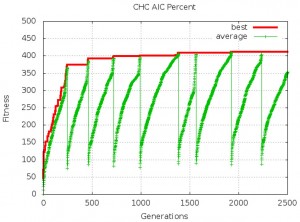From the original news article from PhysOrg:
An evolutionary computation approach developed by Franklin University’s Esmail Bonakdarian, Ph.D., was used to analyze data from two classical economics experiments. As can be seen in this figure, optimization of the search over subsets of the maximum model proceeds initially at a quick rate and then slowly continues to improve over time until it converges. The top curve (red) shows the optimum value found so far, while the lower, jagged line (green) shows the current average fitness value for the population in each generation.
(…)
Regression analysis has been the traditional tool for finding and establishing statistically significant relationships in research projects, such as for the economics examples Bonakdarian chose. As long as the number of independent variables is relatively small, or the experimenter has a fairly clear idea of the possible underlying relationship, it is feasible to derive the best model using standard software packages and methodologies.
However, Bonakdarian cautioned that if the number of independent variables is large, and there is no intuitive sense about the possible relationship between these variables and the dependent variable, “the experimenter may have to go on an automated ‘fishing expedition’ to discover the important and relevant independent variables.”
You can see the original research paper here.
